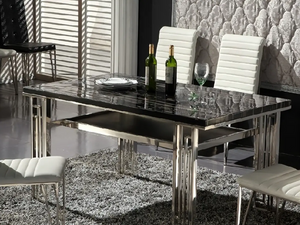
Inspection | Glass Furniture Inspection Standards and Methods
Detailed Explanation of Glass Furniture Inspection Standards and Requirements
1. Size requirements
2. Appearance requirements
(1) Glass pieces
- Surface coating : There must be no defects such as light transmittance, yellow spots, black spots, deplating, rust, impurities, etc.
- Printing and pattern : The color must be uniform, the surface must be clean and tidy, without water marks, oil marks, pores, and obvious color difference.
- Gluing : must be firm and not loose, and the seams must fit tightly.
- Grooves and edges : The edges should be smooth and without cutting edges, and the inlays should be reasonably firm without any looseness.
- Moving parts : Connecting and fixing parts must be firmly installed; moving parts must be easy to use; locking devices must be securely locked; parts that are prone to dangers such as pinching must have protection or buffering devices; parts that are prone to misoperation must have warning signs.
- Surface carving, etc .: The concave and convex lines must be clear and even, without any cutting edges or burrs.
- Load-bearing glass turntable : must be made of tempered glass.
- Scratch requirements : For tempered glass, semi-tempered glass and their laminated glass components, the allowed scratches per square meter are as follows: no more than 4 minor scratches with a width of less than 0.1mm and a length of ≤100mm; no more than 4 scratches with a width of 0.1mm~1mm and a length of ≤100mm.
- Clamp mark requirements : The distance between the clamp mark and the glass edge (see Appendix A for details) must be ≤20mm, and the edge deformation must be ≤2mm.
(2) Wooden parts
- There are no through cracks; there is no rotten material on the surface, and the area of slight decay on the inner surface does not exceed 20% of the part area.
- The materials used for the exterior and storage areas do not contain resin capsules.
- The width of the external nodes shall not exceed 1/3 of the material width and the diameter shall be ≤12mm (except for special designs).
- Dead knots, holes and skin inclusions need to be repaired. After repair, the number of defects on the surface shall not exceed 4, and the number of defects on the internal surface shall not exceed 6 (except for design requirements, and defects with the largest single length or diameter less than 5mm shall not be counted).
- Other minor material defects (such as non-through cracks, blunt edges, etc.) need to be repaired.
(3) Artificial panels
- There are no dry or wet flowers on the surface, and the area of dry or wet flowers on the inside does not exceed 5% of the board surface.
- On the same board surface, one stain is allowed and the area shall be ≤30mm².
- There are no obvious scratches, indentations, color differences, bubbles, cracks or delamination on the surface.
(4) Paint film on the surface of wooden parts
- Parts of the same color have similar color and no fading or discoloration.
- The coating shall be free of wrinkles, stickiness or paint leakage, and shall be flat, smooth and clear, without obvious particles, bulging edges, obvious processing marks, scratches, fog, white edges, white spots, bubbles, oil whitening, sagging shrinkage holes, brush hairs, powder accumulation and debris, and the number of defects shall not exceed 4.
(5) Metal parts
- The pipes should be free of cracks and overlaps, and the exposed pipe ends should be sealed.
- The wall thickness of supporting metal parts shall be ≥1.2mm.
- Welding parts: There is no desoldering, cold welding, welding through, dislocation, slag inclusion, air hole, weld bead, wire head, undercut, spatter at the welding point. The surface corrugation of the weld scar is uniform, and the height difference is ≤1mm.
- The stamped parts have no delamination or cracks; the riveted parts are firmly riveted, with no exposed or detached rivets; the rivets are straight and smooth, with no obvious hammer marks.
- The difference in wrinkle height between round tubes and flat wire tubes at the bends is ≤0.4mm, and the arc shape of the bends is smooth and consistent.
- The spray coating shall be free of spraying gaps and rust, and shall be smooth and uniform in color, without defects such as sagging, bumps, wrinkles, and paint flying; the surface of the electroplated layer shall be free of peeling, rust, burrs, burning, bubbles, pinholes, cracks, spots (excluding colored zinc plating) and scratches.
(6) Plastic parts
(7) Soft and hard packaging
- The covering fabric has a complete and symmetrical pattern, the pile direction of the velvet fabric in the same part is consistent, and there is no obvious color difference.
- The fabric is free of damage, scratches, color stains and oil stains.
- The surface of the soft cover should be flat and full, with uniform tightness and no obvious wrinkles; symmetrical technological wrinkles should be even and clearly layered.
- The exposed foam nails are arranged neatly with basically equal spacing, and there is no obvious flattening or paint peeling.
- The sewing stitches are evenly spaced, with no obvious floating threads, skipped stitches, exposed thread ends, thread fall-offs, open seams, or debonding.
- The hard package has a smooth appearance and no wrinkles.
- The one-piece foam molding parts are firmly combined and flat, without defects such as falling off, wrinkling, and loosening.
- The self-skinning parts have a flat and smooth appearance without pits, uniform thickness, dense texture, and the parting gap does not affect the appearance.
(8) Others
- There are no burrs, cutting edges, sharp edges or sharp corners in the parts that can be touched by the human body or hands.
- The connection of fixed parts is firm and not loose, and there are no missing parts, nails or through nails (except reserved holes and optional holes).
- All painted surfaces of the product will not discolor or fade.
(9) Carpentry
- The non-intersection surfaces of artificial board components need to be edge-sealed or painted.
- There should be no burrs, cutting edges or sharp corners on the parts of panels or components that come into contact with the human body or stored objects.
- The surface of the plate or component is smooth, and the chamfers, fillets and circular lines are uniform.
- There is no debonding, bubbling or cracking in the veneer, edge sealing and edge wrapping, and the veneer is tight and flat with no obvious glue seepage.
- There are no breaks in the joints of tenons, corner plugs, parts, etc., and the joints are tight and firm.
- Various accessories and connectors are installed without missing parts, nails or through nails (except reserved holes and optional holes), and are tight, flat, straight and firm, with no cracks or looseness at the joints.
- The opening and closing components are flexible to use after installation.
- The carved patterns are even, clear, and well-layered. The symmetrical parts are symmetrical, and there are no missing corners in the concave and convex parts, large digging parts, bridges, edges and corners, and arcs. The bottom of the shovel is flat, and there are no hammer marks or burrs in each part. The number of defects for each item does not exceed 4.
- The lines of the turned wood are consistent, the concave and convex levels are symmetrical, the symmetrical parts are symmetrical, the turning lines are clear, there are no burrs, knife marks, or sand marks on the processed surface, and there are no more than 4 defects.
- The furniture locks into place and opens flexibly; the casters can rotate or slide flexibly.
3. Physical and chemical properties and safety requirements
(1) Glass coating resistance to neutral salt spray
(2) Hardness of glass inkjet and printed decorative surfaces
(3) Thermal shock resistance
- For glass furniture that is frequently used outdoors and has high-temperature resistance requirements, tempered glass and its laminated glass components should withstand a temperature difference of 200°C without being damaged; semi-tempered glass and its laminated glass components should withstand a temperature difference of 100°C without being damaged.
- Glass parts used for placing dining utensils or exposed to high temperatures should be free of cracks and discoloration after a 150°C dry heat test.
(IV) Performance and dimensional safety
- If flat glass is used for non-floor-standing doors, the height of the lower edge of the flat glass from the ground should be ≥1.3m, the area should comply with the requirements of Table B.1, and frameless and semi-frame flat glass doors should not be used.
- For floor-standing doors whose main material is glass, tempered glass and laminated glass should be used.
(V) Glass component assembly safety
- There are no cracks or chipped corners on the exposed glass parts.
- The exposed edges of glass components need to be processed (without defects that may scratch the human body). The exposed parts of tempered glass, semi-tempered glass and laminated glass are allowed to have broken edges: each glass component is allowed to have a broken edge with a length of ≤10mm per meter of side length, a depth of ≤2mm from the edge to the surface, and a depth of ≤1/3 of the thickness from the panel surface, and the number of broken edges shall not exceed 1.
- The thermal expansion and deformation space reserved around the glass component and between other components is 1mm~2mm.
- When glass furniture is equipped with lamps on structural parts or shelves, filmed glass and laminated glass should not be used in this area to avoid safety hazards caused by heating of the parts when the lights are turned on.
- The edges of circular holes in glass components must be free of burrs or other defects that may cause harm to the human body. The aperture D of decorative holes that can be inserted with fingers should be greater than 20mm; the aperture of tempered glass and semi-tempered glass components must also comply with the provisions of Appendix C.
4. Mechanical performance requirements
(1) Tables
- Stability : No tipping.
- Strength and durability : There are no breaks or cracks in parts; there is no wear or deformation that seriously affects the function of use; there is no permanent looseness in parts that should be firm when pressed by hand; there is no looseness in the connection parts; the movable parts (doors, drawers, etc.) can be opened and closed flexibly; there is no obvious deformation or damage to the furniture hardware.
(2) Cabinets
- Stability : No tipping.
- Strength and durability : consistent with the strength and durability requirements of tables.
(3) Load-bearing glass turntable
- Turntable torque : After evenly distributing the load on the turntable, the starting torque is ≤7.0N·m.
- Unilateral static load : After the test, the turntable has no contact with the frame, tabletop, turntable and other connecting parts, and there is no damage, and it moves freely.
- Vertical impact strength : After the impact test, the turntable has no damage and rotates flexibly.
We provide professional third-party inspection and factory inspection services to ensure that the final tableware and kitchenware products delivered comply with standards, regulations and target market requirements, avoid disputes due to product quality issues, and improve supply chain management and quality control measures.
Share this product

Inspection | Glass Furniture Inspection Standards and Methods
Glass furniture is mainly made of glass parts and components or composed entirely of glass parts and components. Common types include glass sliding doors, glass coffee tables, glass dining tables, glass display cabinets, glass decorative cabinets, etc. When inspecting this type of furniture, it is necessary to strictly check the size, appearance, physical and chemical properties, safety, mechanical properties and other dimensions.
